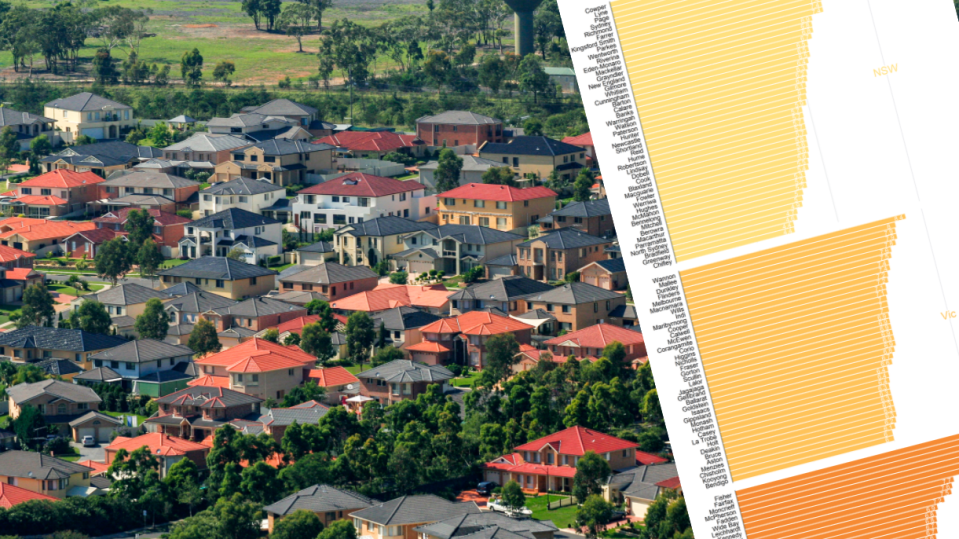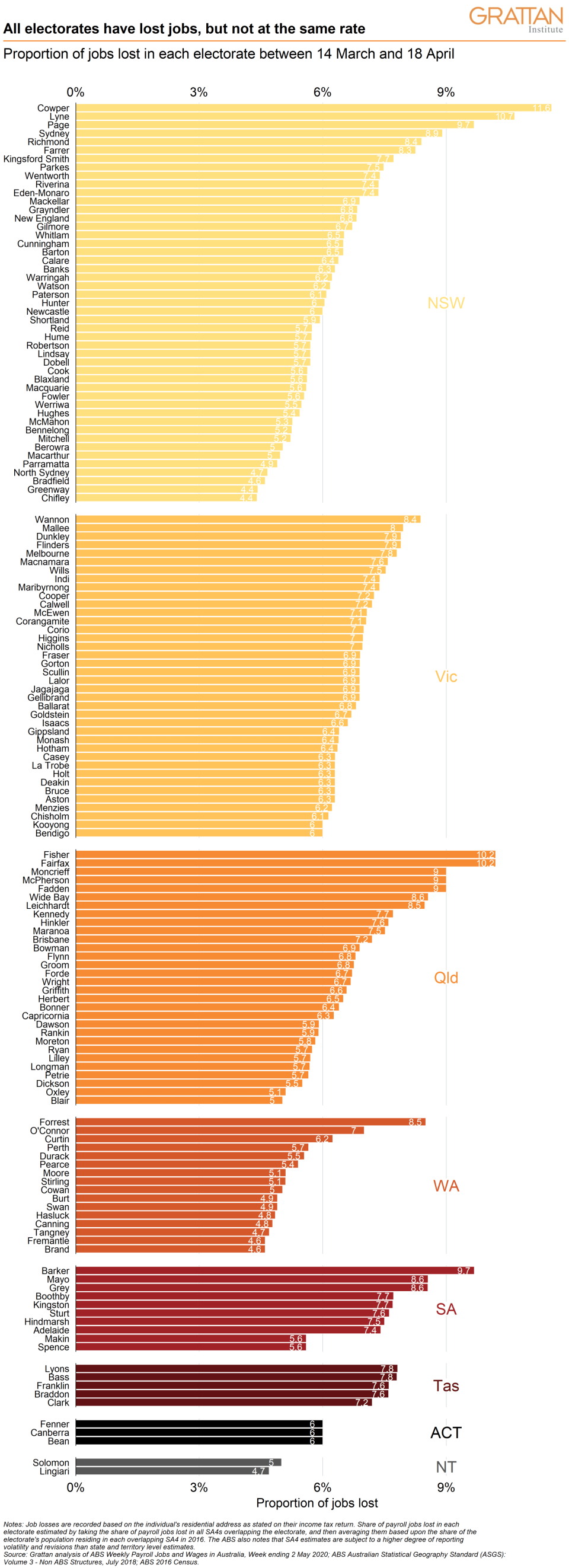The suburbs with the most job losses

More than 1 million Australians have lost their jobs since the coronavirus pandemic drove a sledgehammer through the economy in early March.
Also read: RBA makes May interest rate decision
Also read: How will we pay for coronavirus?
Also read: ‘Vicious cycle’: Coronavirus dents equality
But some suburbs, regions and electorates have been hit harder than others, two major studies have revealed.
The Centre of Full Employment and Equity released its latest Employment Vulnerability Index research identifying areas with the highest proportions of at-risk jobs, using ABS Census data.
The researchers looked at the suburbs with the highest proportion of jobs requiring lower skill levels and the number of people in casual and part-time positions.
In Sydney, the suburbs described as high risk were:
Bidwill,
Hebersham,
Emerton,
Greenfield Park,
Prairiewood,
Fairfield,
Edensor Park,
Canley Vale,
Cabramatta,
Lansvale,
Bonnyrigg,
Green Valley,
Punchbowl,
Auburn,
Fairfield,
Ashcroft,
Busby, and
Miller.
In Melbourne, those suburbs at high risk were:
Rosebud,
McCrae,
Dandenong,
Springvale,
Noble Park,
Cairnlea,
Delahey,
Kings Park,
St Albans - North,
St Albans - South,
Sunshine North,
Taylors Lakes,
Dromana,
Point Nepean,
Narre Warren South (East),
Pearcedale - Tooradin,
Cranbourne South,
Lalor,
Thomastown,
Epping - South,
Broadmeadows,
Campbellfield - Coolaroo,
Gladstone Park - Westmeadows,
Greenvale - Bulla,
Meadow Heights,
Narre Warren - North East,
Narre Warren North,
Hallam,
Doveton,
Craigieburn - Central, and
Roxburgh Park - Somerton.
In Brisbane, the highest-risk suburbs were:
Redland Islands,
Upper Caboolture,
Caboolture - South,
Bribie Island,
Woodridge,
Logan Central,
Eagleby,
Beenleigh,
Inala - Richlands, and
Sunnybank.
And in Adelaide, these were the highest-risk suburbs:
Lewiston - Two Wells,
The Parks,
Morphett Vale - West,
Morphett Vale - East,
Hackham West - Huntfield Heights,
Hackham - Onkaparinga Hills,
Christie Downs,
Salisbury North,
Salisbury East,
Salisbury,
Craigmore - Blakeview,
Davoren Park,
Elizabeth,
Elizabeth East,
Smithfield - Elizabeth North,
Parafield Gardens, and
Paralowie.
In Perth, these suburbs were highest-risk:
Dawesville - Bouvard,
Alexander Heights - Koondoola,
Girrawheen,
Marangaroo,
Mindarie - Quinns Rocks - Jindalee,
Calista,
Parmelia - Orelia,
Cooloongup,
Warnbro,
Stratton - Jane Brook,
Ballajura,
Falcon - Wannanup,
Greenfields,
Halls Head - Erskine,
Mandurah,
Mandurah - East,
Mandurah - North,
Mandurah - South, and
Pinjarra.
Down in Tasmania, these were Hobart’s red zones:
Bridgewater - Gagebrook,
Glenorchy,
Claremont (Tas.),
Berriedale - Chigwell,
Rokeby,
Mornington - Warrane, and
Brighton - Pontville.
The Employment Vulnerability Index only returned one high-risk suburb for Canberra and Queanbeyan communities: Acton, while Darwin didn’t have any high or medium-high risk suburbs.
Where did the jobs actually go?
While the Employment Vulnerability Index measured the areas at risk, new research from the Grattan Institute identifies the electorates where workers have actually lost work.
Researchers Brendan Coates and Tony Chen analysed ABS payroll data for the period from the week ending 14 March to the week ending 18 April.
“Unsurprisingly, electorates with large tourism industries and a high share of hospitality workers have been hit especially hard,” Coates and Chen said.
“The two worst-affected electorates are Cowper (11.6 per cent of jobs lost) and Lyne (10.7 per cent), around the Mid North Coast of NSW and Coffs Harbour.”
Cowper includes Coffs Harbour, Port Macquarie, Kempsie, Macksville and Nambucca Heads while Lyne covers Bonny Hills, Bulahdelah, Dungog, Forster, Gloucester, Gresford, Harrington, Hawks Nest, Lake Cathie, Lansdowne, Laurieton, Nabiac, North Haven, Old Bar, Paterson, Smiths Lake, Stroud, Taree and Wauchope.
“The third and fourth worst-affected are Fairfax (10.2 per cent) and Fisher (10.2 per cent), covering the Sunshine Coast in Queensland.”
Fairfax includes Coolum, Yaroomba, Marcoola, Mudjimba, Maroochydore, Buderim, Woombye, Bli Bli, Yandina, Nambour, Mapleton, Kenilworth and Eumundi, while Fisher covers Caloundra, Mooloolaba, Beerwah, Maleny, Woodford and Kilcoy.
“A larger share of workers in these electorates are employed in accomodation and food services, which saw 33 per cent of jobs lost by 18 April. Of the 10 worst-hit electorates, five are in Queensland, four in NSW, and one in South Australia.”
But the researchers found that no electorates were immune, with even those least-affected, like Chifley, still suffering job losses of 4.4 per cent.
Chifley holds Bidwill, Blackett, Bungarribee, Colebee, Dean Park, Dharruk, Doonside, Emerton, Glendenning, Hassall Grove, Hebersham, Lethbridge Park, Marayong, Marsden Park, Mount Druitt, Oakhurst, Plumpton, Rooty Hill, Ropes Crossing, Shalvey, Shanes Park, Tregear, Whalan, Willmot, and Woodcroft; and portions of Arndell Park, Blacktown, Eastern Creek, Huntingwood, Quakers Hill, Riverstone, and Schofields.
Job losses by electorate

Regional and rural areas have also suffered a tougher blow than their metropolitan counterparts, the researchers found.
In fact, eight of the 10 hardest-hit electorates were in rural and regional Australia.
“Half of all rural electorates lost more than 7.5 per cent of jobs between 14 March and 18 April, compared to 16 per cent of inner-metropolitan electorates and 11 per cent of outer-metropolitan electorates.”
Coalition-held electorates made up most of the hardest-hit areas, with Tanya Plibersek’s inner-Sydney electorate the only Labor electorate to rank in the top 10 worst-hit electorates.
Among the 10 least-affected areas nine are in metropolitan areas, with five Labor and five Coalition.
Follow Yahoo Finance Australia on Facebook, Twitter, Instagram and LinkedIn.

 Yahoo Finance
Yahoo Finance 

